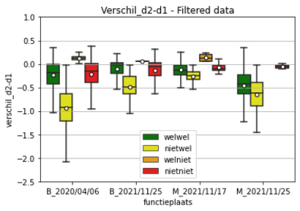...
- Water Injection Dredging (WID) monitoring and modelling
- Large scale experiments in water-soil flume Deltares
- Data science for optimizing dredging
Our products will be:
- Open-source datasets and models
- Technical reports and scientific publications
- Description of this project for general audience on the website
Work package 1 : Water Injection Dredging (WID) monitoring and modelling
...
In-situ monitoring of WID activities in the Calandkanaal area of the Port of Rotterdam (PoR) indicates that the increase of turbidity caused by WID remains close to the bed.
For modelling WID density currents rheological models are implemented in a 3D CFD (computational fluid dynamics) model TUDflow3D. With TUDflow3D the near-bed density current generated by a WID dredge can be simulated including the non-Newtonian flow aspect caused by the high concentration mud rheological behavior. The 3D CFD simulations can be used to optimize WID activities and to investigate where and how fast the near-bed WID density current will flow and where it will stop flowing.
...
Additionally, the coupling tool (Cosumo) is extended to be able to couple a local near-field CFD model TUDflow3D to a far-field Delft3D model for WID density currents. With this coupling tool we are able to translate the near-field physics and WID density current characteristics from the CFD model in proper far-field source terms for Delft3D.
To enhance our system knowledge and to prepare for the future a quick scan into the possible influence of sea-level rise (SLR) on port sedimentation in Rotterdam is investigated. The scenarios with SLR show that 1m SLR as simulated schematically impacts the hydrodynamics, the dynamics of the salt wedge, the influence of wave-induced resuspension on the North Sea and subsequently the sedimentation in the port area noticeably. Especially for port basins near the location of the estuarine turbidity maximum at the end of the intrusion of the salt wedge the sedimentation is altered by SLR. Sedimentation in the Botlek (-14%) and Europoort (-22%) slightly decreases in the scenario with SLR, whereas sedimentation increases in the basins near the new location of the salt wedge (i.e. Pernis, Waalhaven, Fruithaven, approx.+15%).
Work package 2 : Large scale experiments in water-soil flume Deltares
...
In the third work package data science is applied to already available in-situ datasets of dredging activities to optimize future dredging activities. . The dredging trips are linked to the bathymetric survey before and after dredging and compared to the NGD (Nautical Guaranteed Depth). It is investigated how much of the trip dredging helped to comply with NGD and how much is preventive dredging where the depth already complied with NGD. Dredge trip data like the suction pipe density or difference in bathymetry before/after dredging are correlated to the classification of compliance with NGD, see for example the figure below. Dredging operations can be optimized.
Products
The project is not finished yet. But the following products are already following publications are available:
- MSc report A. Goda 2021 Rheological and plate’s hydrodynamic resistance in fluid mud measurements for the nautical bottom applicationshttps://repository.tudelft.nl/islandora/object/uuid%3Adb54cf8e-53ca-4387-94d5-1e0a3945df35?collection=education
- MSc report E. ten Brummelhuis 2021 Modelling of high concentration fluid mud water injection dredging density currents https://repository.tudelft.nl/islandora/object/uuid%3Ae4b50eee-adce-4847-9ed5-4528b58658c0?collection=education
- MSc report TU Delft: S. Ma 2022 Laboratory study on the efficiency of water injection dredging: An analysis on the influence of different dredge settings on the density current and production rate https://repository.tudelft.nl/islandora/object/uuid%3Ac446d61a-9073-438d-aa1e-1f3c22045bd0
- MSc internship report WUR: C.C. Panez 2022 Data-driven assessment of port maintenance efficiency: Case study Port of Rotterdam
- Conference paper: Wit, L. de, E. ten Brummelhuis & A. Talmon (2022), 3D CFD modelling of water injection dredging including mud rheology, Proceedings of the 23th World Dredging Conference WODCON XXIII, Copenhagen, Denmark
- Journal publication: S.Lovato, A.Kirichek, S.L.Toxopeus, J.W.Settels, G.H.Keetels (2022), Validation of the resistance of a plate moving through mud: CFD modelling and towing tank experiments, Ocean Engineering, volume 258, https://doi.org/10.1016/j.oceaneng.2022.111632
An overview report of TKI Prisma 2 is available here.


